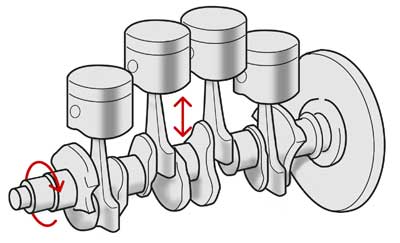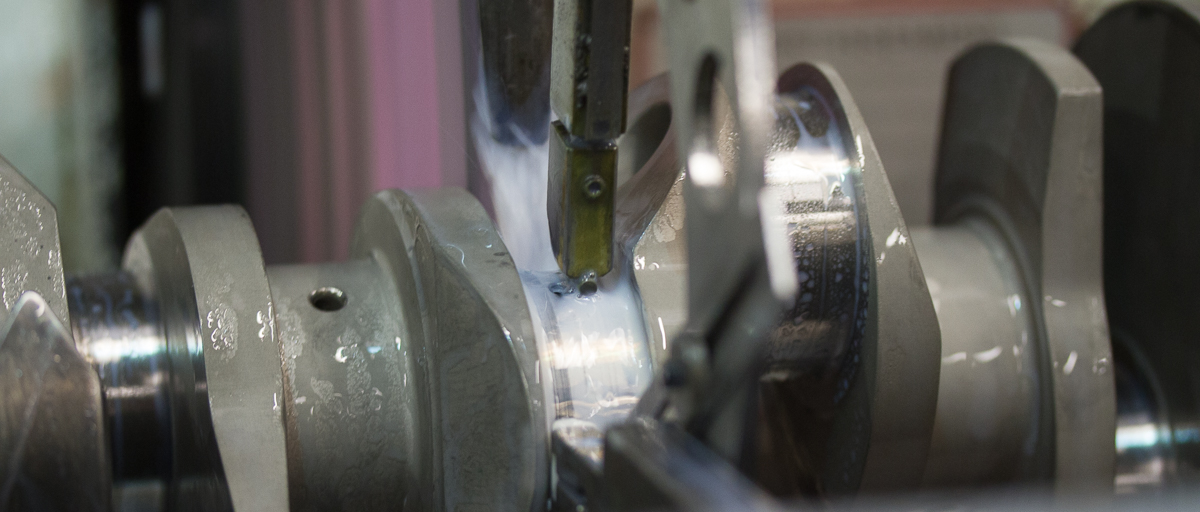
Automotive Crankshafts, Part 1 – Cost-Effective Surface Improvement for Key Engine Components
, roslerusa - Terug naar overzicht
Crankshafts are a key component of internal combustion engines, be it mass-produced engines for motorcycles and automobiles, engines for heavy trucks, off-high highway equipment, and even large ships.
Crankshafts convert the reciprocating (up/down)
movement of the pistons/connecting rods into a rotational movement that drives
the wheels and allows a vehicle to move forward.
Rosler Metal Finishing understands the vital importance of these engine components and has developed specific shot blasting and mass finishing machines to process these pieces to perfection.
A crankshaft with connected rods and pistons
Materials &
Production Methods
Considering that automotive crankshafts weigh around
40-60 pounds and rotate approximately 100 times per second, these parts are
exposed to tremendous tensile, compressive, and shear stresses. In addition,
combustion forces and piston acceleration in an engine can also cause
significant vibration.
Therefore, crankshafts must be made from tough,
wear-resistant materials, usually high alloy carbon steel. Typical alloying
elements are manganese, chromium, molybdenum, nickel, cobalt, or vanadium.
The most common materials are AISI/SAE 4340,
EN-30B, 4330-M, 32-CrMoV-13, or 300-M.
Crankshafts are made by:
- Casting – The production of cast iron crankshafts is limited to cheaper production engines, for example, low-performance diesel engines with lower overall loads.
- Hot forging – Today the most common manufacturing method is hot forging at temperatures of 1,700 to 2,100° F. Compared to casting, forged cranks offer a higher strength with – at the same time – lower weights and somewhat more compact dimensions. Depending on the utilized steel alloy, forged crankshafts may have to undergo a heat treatment process in the form of tempering and quenching. This is generally done after forging, but sometimes also after machining.
- Complete machining from a steel billet – This method is quite costly and is predominantly used for motorsport and high-performance applications, never for high-volume engine production.
A hot-forged crankshaft
After forging or casting, crankshafts must undergo
an intensive machining process that includes:
- Turning of the journals, sometimes also called crankpins.
- Drilling of the oil holes in the journals.
- Drilling of the balancing holes in the counterweights.
- Milling of the drive sprockets, etc.
Surface Treatment Tasks
The main surface cleaning/treatment tasks for
crankshafts include:
- Blast cleaning after forging or casting.
- Shot peening after machining.
- Deburring after machining.
Blast cleaning after forging or casting is
required because the forging/casting/heat treatment process leaves a relatively
strong layer of scale on crankshafts and other work pieces. Prior to subsequent
production processes such as machining and micro finishing, the work pieces
must undergo a blast cleaning process to create a surface finish of SA 3, i.e.
a pure white metal surface without any scale residues whatsoever.
Crankshafts before and after blast cleaning
The high compressive, shearing, and tensile stresses
that crankshafts are exposed to as a result of machining can be relieved
significantly by shot peening. In this application, the peening process focuses
on the journals, especially the bearing surfaces as well as the journal fillets
and journal cheeks (counterweights). Crankshaft peening is usually done by air
blasting with relatively fine steel media.
Deburring after machining is required to smooth
edges including those of counterweight cheeks, drilled balancing holes in the counterweights,
milled drive sprockets, and, sometimes, drilled oil holes in the journals. It
is extremely important that the bearing areas on the journals are not damaged. The
deburring operation is frequently done by mass finishing.
Crankshaft machining
The Rosler Way
Whatever type of engine your crankshafts are designed for, Rosler can develop equipment and a process to provide accurate and repeatable finishing results. We are proud to lend our surface finishing expertise to the automotive industry. Contact us today to discuss your unique challenges.
The complete Automotive Series includes:
- Part 1 – Cost-Effective Surface Improvement for Key Engine Components.
- Part 2 – Shot Blasting Machines Designed for Crankshafts.
- Part 3 – Typical Mass Finishing Machines Used for Crankshafts.
Sign up for enews alerts to be notified of all Rosler blog posts!




